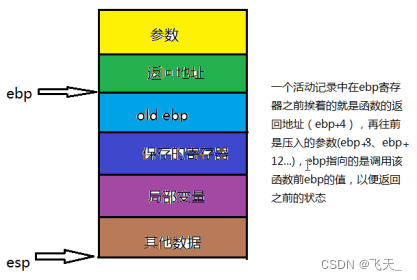当前位置:网站首页>Post training quantification of bminf
Post training quantification of bminf
2022-07-06 08:57:00 【cyz0202】
BMINF
- BMINF It is a large model reasoning tool developed by Tsinghua University , At present, it is mainly for the team CPM Series of models for inference and optimization . The tool realizes memory / Video memory scheduling optimization , utilize cupy/cuda It realizes post training quantification And so on , This paper records and analyzes the post training quantization implementation of the tool .
- Main concern cupy operation cuda Realize the quantitative part , The principles involving quantification may not be introduced in detail , Readers need to consult other materials ;
- BMINF The team has recently refactored more code ; The code example I use below is 8 Months ago , Readers want to see BMINF Corresponding source code , Please check out 0.5 edition
Implement code analysis 1
The entry code of the quantification part is mainly in tools/migrate_xxx.py, Here we use tools/migrate_cpm2.py For example ;
main function
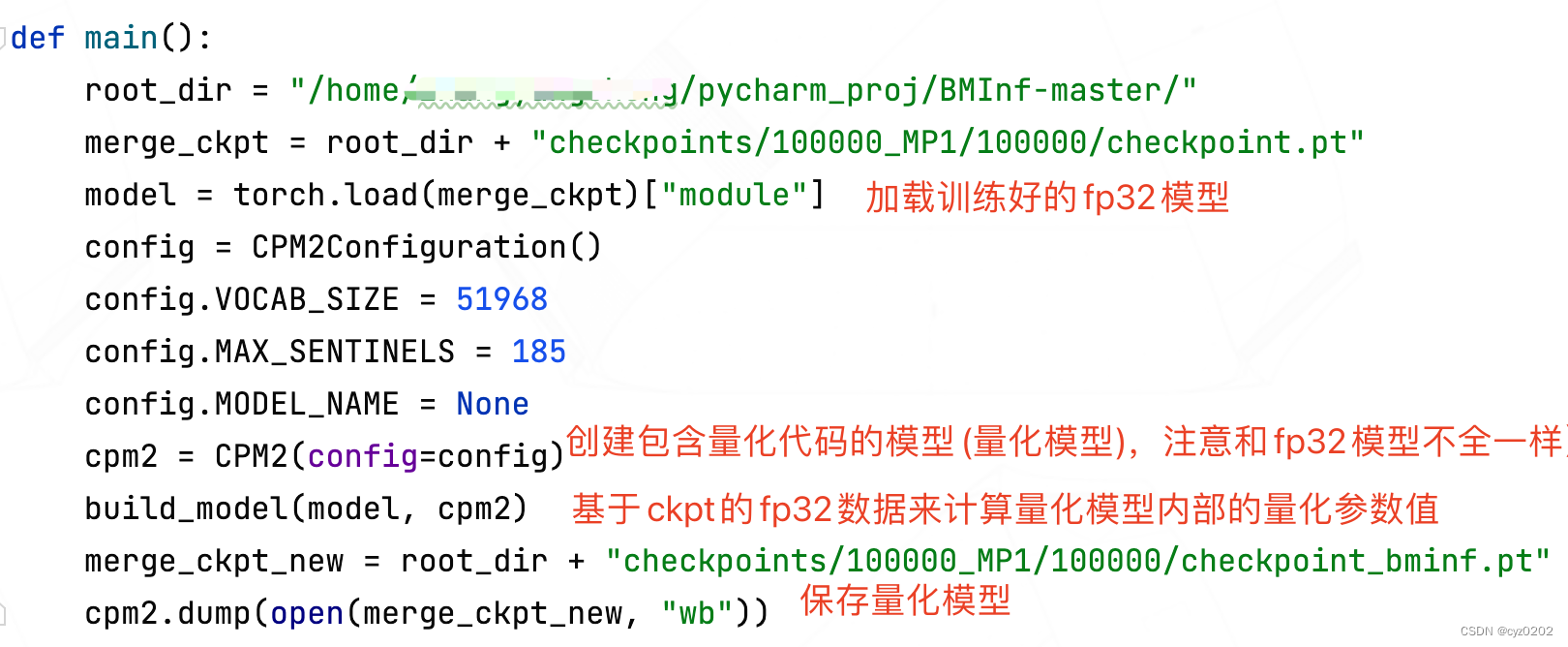
build_model function : be based on ckpt Of fp32 Calculate the quantitative parameter value inside the quantitative model
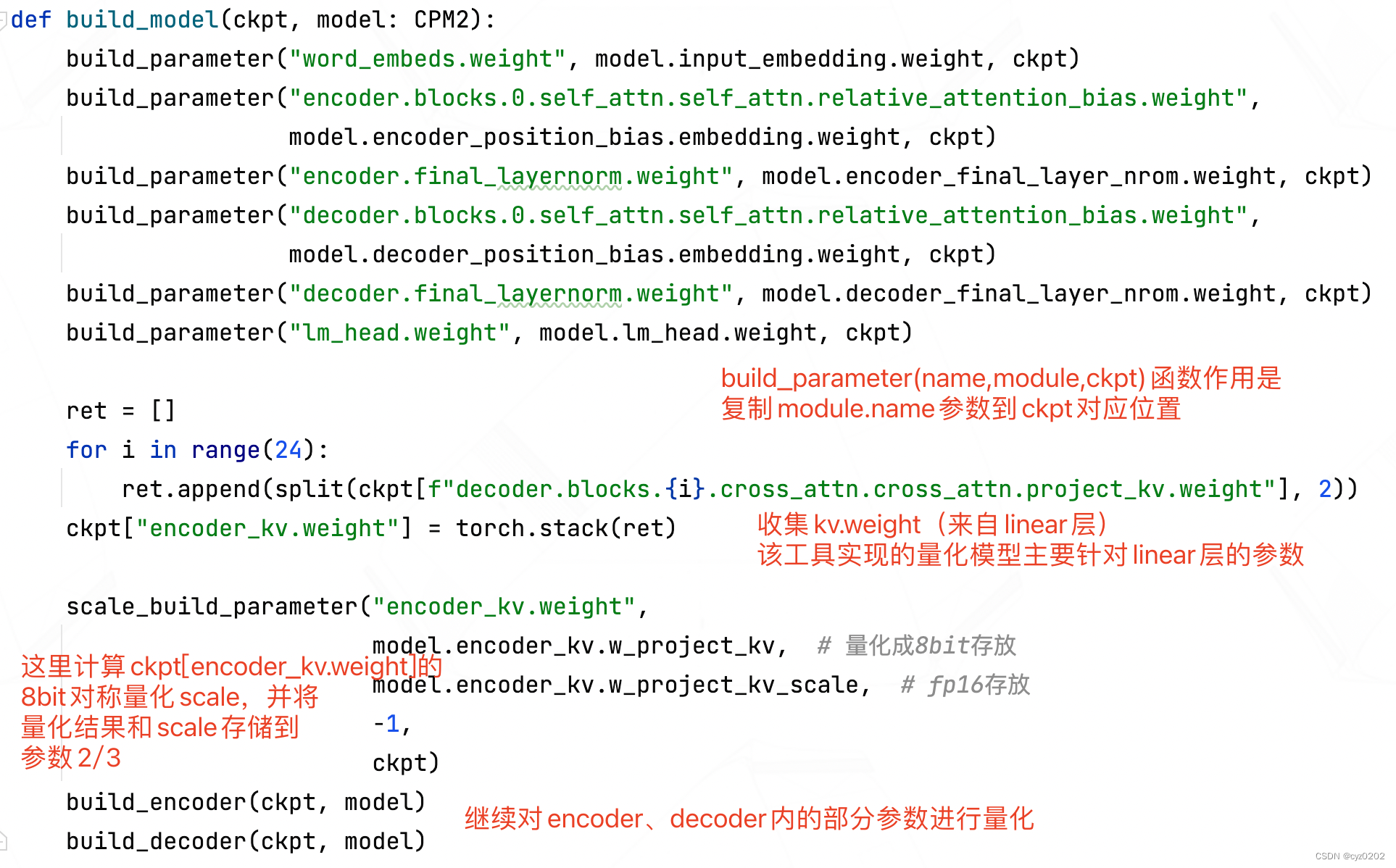
scale_build_parameter function : Calculate symmetrically quantized scale, And will scale And put the quantitative results into the corresponding parameters of the quantitative model ( It corresponds to model.encoder_kv.w_project_kv_scale and w_project_kv)

Take a look at how to save the quantitative results model.encoder_kv.w_project_kv_scale and w_project_kv How to define it

build_encoder/decoder function : Main call build_block, Deal with each block(layer)

build_block function : Or copy part module The parameters and quantification of another part module Parameters of
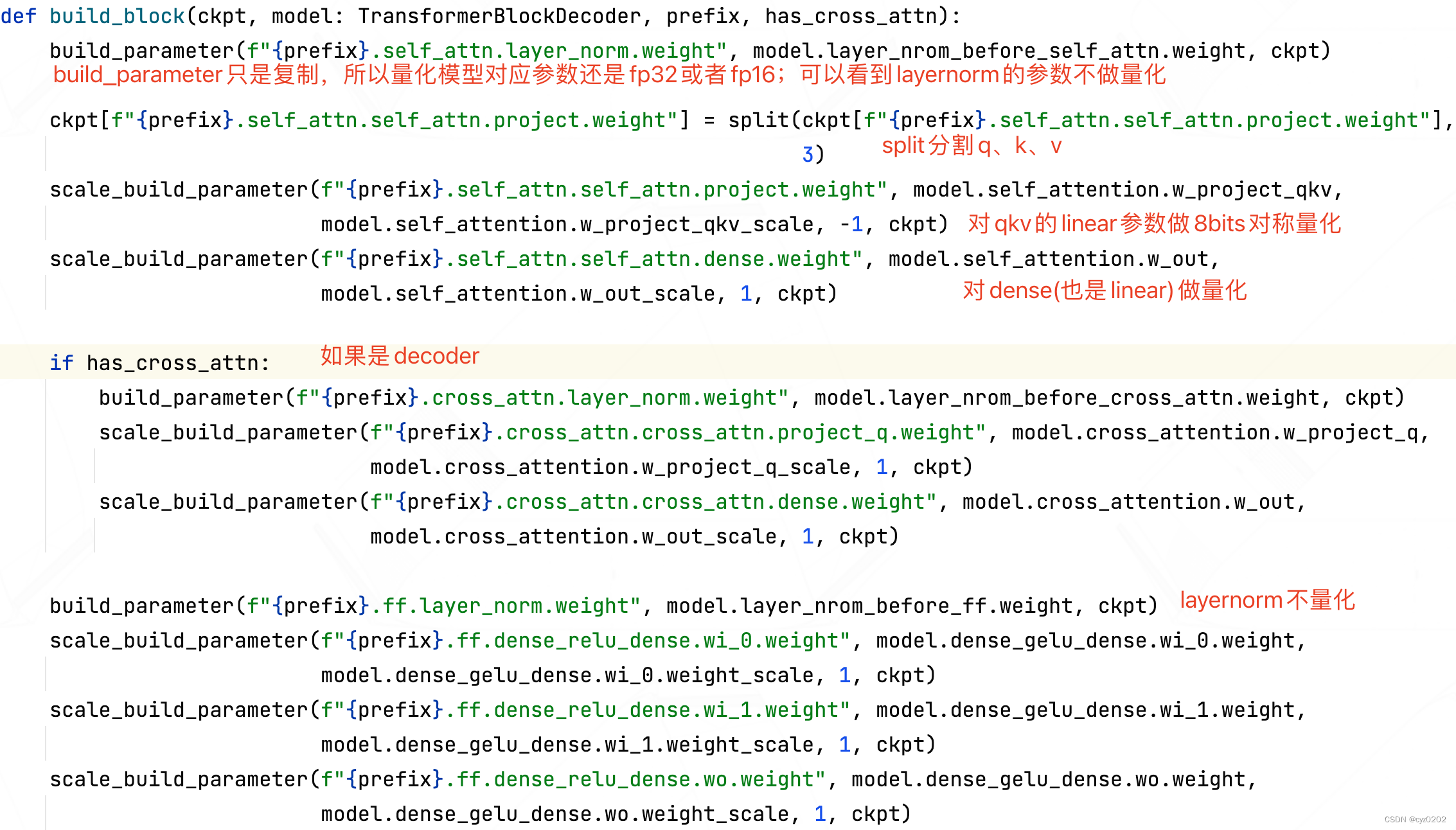
Summary : From fp32 The model will have different parameters copy To the realization of the corresponding position of the quantitative model ; Next, we will introduce how to use quantitative parameters in the quantitative model +cupy+cuda Calculate , Achieve acceleration ;
Implement code analysis 2
- With decoder Use attention module: partial_attetion Take an example for analysis (bminf/layers/attention)
- Go straight to the code , Please see comments
class PartialAttention(Layer):
def __init__(self, dim_in, dim_qkv, num_heads, is_self_attn):
self.is_self_attn = is_self_attn # self_attn still cross_attn
self.dim_in = dim_in
self.num_heads = num_heads
self.dim_qkv = dim_qkv
if self.is_self_attn:
self.w_project_qkv = Parameter((3, dim_qkv * num_heads, dim_in), cupy.int8) # Weight usage int8 quantitative , Here will receive fp32 Of ckpt The quantized results of corresponding parameters
self.w_project_qkv_scale = Parameter((3, dim_qkv * num_heads, 1), cupy.float16) # scale Use fp16; It is worth noting that scale It's right dim_in Of this dimension
else:
self.w_project_q = Parameter((dim_qkv * num_heads, dim_in), cupy.int8) # cross_attn shape It's a little different
self.w_project_q_scale = Parameter((dim_qkv * num_heads, 1), cupy.float16)
# Do it again before output linear
self.w_out = Parameter((dim_in, dim_qkv * num_heads), cupy.int8)
self.w_out_scale = Parameter((dim_in, 1), cupy.float16)
def quantize(self, allocator: Allocator, value: cupy.ndarray, axis=-1):
""" Quantization function ,allocator Allocate video memory ,value It is to be quantified fp16/32 value ;axis It's a quantitative dimension Notice a nested quantize function , This is real work ======================================================== Here are quantize Implementation of function : def quantize(x: cupy.ndarray, out: cupy.ndarray, scale: cupy.ndarray, axis=-1): assert x.dtype == cupy.float16 or x.dtype == cupy.float32 assert x.shape == out.shape if axis < 0: axis += len(x.shape) assert scale.dtype == cupy.float16 assert scale.shape == x.shape[:axis] + (1,) + x.shape[axis + 1:] # scale on gpu Calculation scale( Symmetry mode ) quantize_scale_kernel(x, axis=axis, keepdims=True, out=scale) quantize_copy_half(x, scale, out=out) # Calculation Quantitative results ======================================================== Here are quantize_scale_kernel and quantize_copy_half/float The implementation of the : # Back to quantize_scale_kernel It's a cuda The function on , Calculation quantification scale quantize_scale_kernel = create_reduction_func( # kernel finger cuda The function on , Here is the cupy Give Way cuda Create the corresponding function (kernel) 'bms_quantize_scale', # Name of the function created ('e->e', 'f->e', 'e->f', 'f->f'), # Specify the input -> Output data type ( come from numpy, Such as e representative float16,f yes float32) ('min_max_st<type_in0_raw>(in0)', 'my_max(a, b)', 'out0 = abs(a.value) / 127', 'min_max_st<type_in0_raw>'), # cuda What will be executed None, _min_max_preamble # If you need to use custom data structures , Write it here , Previous line min_max_st、my_max Is such as bminf Author defined , It's not shown here ) # return quantize_copy_half It's also a cuda function , The function is in cuda Calculate the quantized value on =x/scale; Note that symmetric quantization does not zero_point quantize_copy_half = create_ufunc( 'bms_quantize_copy_half', ('ee->b', 'fe->b', 'ff->b'), 'out0 = nearbyintf(half(in0 / in1))') # half finger fp16 quantize_copy_float = create_ufunc( 'bms_quantize_copy_float', ('ee->b', 'fe->b', 'ff->b'), 'out0 = nearbyintf(float(in0 / in1))') ======================================================== """
if axis < 0:
axis += len(value.shape)
# following 3 Lines allocate video memory to quantized values 、scale
nw_value = allocator.alloc_array(value.shape, cupy.int8)
scale_shape = value.shape[:axis] + (1,) + value.shape[axis + 1:]
scale = allocator.alloc_array(scale_shape, cupy.float16)
# Real quantization function , Calculation scale Value stored in scale in , The calculated quantized value is stored in nw_value in
quantize(value, nw_value, scale, axis=axis)
return nw_value, scale # Return the quantized value 、scale
def forward(self,
allocator: Allocator,
curr_hidden_state: cupy.ndarray, # (batch, dim_model)
past_kv: cupy.ndarray, # (2, batch, num_heads, dim_qkv, past_kv_len)
position_bias: Optional[cupy.ndarray], # (1#batch, num_heads, past_kv_len)
past_kv_mask: cupy.ndarray, # (1#batch, past_kv_len)
decoder_length: Optional[int], # int
):
batch_size, dim_model = curr_hidden_state.shape
num_heads, dim_qkv, past_kv_len = past_kv.shape[2:]
assert past_kv.shape == (2, batch_size, num_heads, dim_qkv, past_kv_len)
assert past_kv.dtype == cupy.float16
assert num_heads == self.num_heads
assert dim_qkv == self.dim_qkv
assert curr_hidden_state.dtype == cupy.float16
if self.is_self_attn:
assert decoder_length is not None
if position_bias is not None:
assert position_bias.shape[1:] == (num_heads, past_kv_len)
assert position_bias.dtype == cupy.float16
assert past_kv_mask.shape[-1] == past_kv_len
# value->(batch, dim_model), scale->(batch, 1) Here is one decoder-step, So there was no seq-len
# Quantify the input
value, scale = self.quantize(allocator, curr_hidden_state[:, :], axis=1)
if self.is_self_attn: # Self attention
qkv_i32 = allocator.alloc_array((3, batch_size, self.num_heads * self.dim_qkv, 1), dtype=cupy.int32)
else:
qkv_i32 = allocator.alloc_array((batch_size, self.num_heads * self.dim_qkv, 1), dtype=cupy.int32)
if self.is_self_attn:
# Self attention ,qkv Linear transformation is required ; Use igemm Give Way cuda perform 8bit matmul;
# Show later igemm Realization
igemm(
allocator,
self.w_project_qkv.value, # (3, num_head * dim_qkv, dim_model)
True, # Transposition
value[cupy.newaxis], # (1, batch_size, dim_model)
False,
qkv_i32[:, :, :, 0] # (3, batch_size, num_head * dim_qkv)
)
else:
# Cross attention , Yes q Do a linear transformation
igemm(
allocator,
self.w_project_q.value[cupy.newaxis], # (1, num_head * dim_qkv, dim_model)
True,
value[cupy.newaxis], # (1, batch_size, dim_model)
False,
qkv_i32[cupy.newaxis, :, :, 0] # (1, batch_size, num_head * dim_qkv)
)
# release value
del value
# convert int32 to fp16 The above linear transformation result int32 Convert to fp16
# Note that the whole process is not single int8 perhaps int Type calculation
assert qkv_i32._c_contiguous
qkv_f16 = allocator.alloc_array(qkv_i32.shape, dtype=cupy.float16)
if self.is_self_attn:
""" elementwise_copy_scale = create_ufunc('bms_scaled_copy', ('bee->e', 'iee->e', 'iee->f', 'iff->f'), 'out0 = in0 * in1 * in2') """
elementwise_copy_scale( # Perform inverse quantization , obtain fp16 Stored in out Inside
qkv_i32, # (3, batch_size, num_head * dim_qkv, 1)
self.w_project_qkv_scale.value[:, cupy.newaxis, :, :], # (3, 1#batch_size, dim_qkv * num_heads, 1)
scale[cupy.newaxis, :, :, cupy.newaxis], # (1#3, batch_size, 1, 1)
out=qkv_f16
)
else:
elementwise_copy_scale(
qkv_i32, # (1, batch_size, num_head * dim_qkv, 1)
self.w_project_q_scale.value, # (dim_qkv * num_heads, 1)
scale[:, :, cupy.newaxis], # (batch_size, 1, 1)
out=qkv_f16
)
del scale
del qkv_i32
# reshape
assert qkv_f16._c_contiguous
if self.is_self_attn:
qkv = cupy.ndarray((3, batch_size, self.num_heads, self.dim_qkv), dtype=cupy.float16, memptr=qkv_f16.data)
query = qkv[0] # (batch, num_heads, dim_qkv)
past_kv[0, :, :, :, decoder_length] = qkv[1] # Store as history kv, Avoid subsequent double counting
past_kv[1, :, :, :, decoder_length] = qkv[2]
del qkv
else:
query = cupy.ndarray((batch_size, self.num_heads, self.dim_qkv), dtype=cupy.float16, memptr=qkv_f16.data)
del qkv_f16
# calc attention score(fp16)
attention_score = allocator.alloc_array((batch_size, self.num_heads, past_kv_len, 1), dtype=cupy.float16)
fgemm( # Calculating the attention score is using float-gemm Calculation
allocator,
query.reshape(batch_size * self.num_heads, self.dim_qkv, 1), # (batch_size * num_heads, dim_qkv, 1)
False,
past_kv[0].reshape(batch_size * self.num_heads, self.dim_qkv, past_kv_len),
# ( batch_size * num_heads, dim_qkv, past_kv_len)
True,
attention_score.reshape(batch_size * self.num_heads, past_kv_len, 1)
# (batch_size * num_heads, past_kv_len, 1)
)
# mask Calculation
""" mask_attention_kernel = create_ufunc( 'bms_attention_mask', ('?ff->f',), 'out0 = in0 ? in1 : in2' # Selectors ) """
mask_attention_kernel(
past_kv_mask[:, cupy.newaxis, :, cupy.newaxis], # (batch, 1#num_heads, past_kv_len, 1)
attention_score,
cupy.float16(-1e10),
out=attention_score # (batch_size, self.num_heads, past_kv_len, 1)
)
if position_bias is not None:
attention_score += position_bias[:, :, :, cupy.newaxis] # (1#batch, num_heads, past_kv_len, 1)
# Calculation softmax float situation
temp_attn_mx = allocator.alloc_array((batch_size, self.num_heads, 1, 1), dtype=cupy.float16)
cupy.max(attention_score, axis=-2, out=temp_attn_mx, keepdims=True)
attention_score -= temp_attn_mx
cupy.exp(attention_score, out=attention_score)
cupy.sum(attention_score, axis=-2, out=temp_attn_mx, keepdims=True)
attention_score /= temp_attn_mx
del temp_attn_mx
# Calculation softmax*V
out_raw = allocator.alloc_array((batch_size, self.num_heads, self.dim_qkv, 1), dtype=cupy.float16)
fgemm( # Still use float gemm
allocator,
attention_score.reshape(batch_size * self.num_heads, past_kv_len, 1),
False,
past_kv[1].reshape(batch_size * self.num_heads, self.dim_qkv, past_kv_len),
False,
out_raw.reshape(batch_size * self.num_heads, self.dim_qkv, 1)
)
assert out_raw._c_contiguous
# obtain softmax(qk)*v result
out = cupy.ndarray((batch_size, self.num_heads * self.dim_qkv), dtype=cupy.float16, memptr=out_raw.data)
del attention_score
del out_raw
# The attention result vector continues to be quantified , So that we can do it again linear
# (batch_size, num_heads * dim_qkv, 1), (batch_size, 1, 1)
out_i8, scale = self.quantize(allocator, out, axis=1)
project_out_i32 = allocator.alloc_array((batch_size, dim_model, 1), dtype=cupy.int32)
# Do it again before output linear projection(igemm)
igemm(
allocator,
self.w_out.value[cupy.newaxis], # (1, dim_in, dim_qkv * num_heads)
True,
out_i8[cupy.newaxis],
False,
project_out_i32[cupy.newaxis, :, :, 0]
)
assert project_out_i32._c_contiguous
# (batch, dim_model, 1)
project_out_f16 = allocator.alloc_array(project_out_i32.shape, dtype=cupy.float16)
# Inverse quantification gets the final attention result fp16
elementwise_copy_scale(
project_out_i32,
self.w_out_scale.value, # (1#batch_size, dim_model, 1)
scale[:, :, cupy.newaxis], # (batch, 1, 1)
out=project_out_f16
)
return project_out_f16[:, :, 0] # (batch, dim_model)
- Summary of the above code : You can see that it is mainly for linear Quantify , Other such as norm、score、softmax Waiting is directly in float16 Count up ; The whole process is int、float Use alternately , quantitative 、 Inverse quantization alternates
- igemm function :cupy How to be in cuda Perform integral matrix multiplication on , It is based on cuda Just write the specification
def _igemm(allocator : Allocator, a, aT, b, bT, c, device, stream):
assert isinstance(a, cupy.ndarray)
assert isinstance(b, cupy.ndarray)
assert isinstance(c, cupy.ndarray)
assert len(a.shape) == 3 # (batch, m, k)
assert len(b.shape) == 3 # (batch, n, k)
assert len(c.shape) == 3 # (batch, n, m)
assert a._c_contiguous
assert b._c_contiguous
assert c._c_contiguous
assert a.device == device
assert b.device == device
assert c.device == device
lthandle = get_handle(device) # For the current gpu establish handler
# obtain batch_size
num_batch = 1
if a.shape[0] > 1 and b.shape[0] > 1:
assert a.shape[0] == b.shape[0]
num_batch = a.shape[0]
elif a.shape[0] > 1:
num_batch = a.shape[0]
else:
num_batch = b.shape[0]
# Calculation stride,batch Inner span sample
if a.shape[0] == 1:
stride_a = 0
else:
stride_a = a.shape[1] * a.shape[2] # m*k
if b.shape[0] == 1:
stride_b = 0
else:
stride_b = b.shape[1] * b.shape[2] # n*k
if aT: # Need to transpose ;aT It's usually True
m, k1 = a.shape[1:] # a [bs,m,k1]
else:
k1, m = a.shape[1:]
if bT:
k2, n = b.shape[1:]
else: # bT It's usually False
n, k2 = b.shape[1:] # b [bs,n,k]
assert k1 == k2 # a*b => k Dimension size should be the same
k = k1
assert c.shape == (num_batch, n, m) # c = a*b
stride_c = n * m
## compute capability: cuda edition
# Ampere >= 80
# Turing >= 75
cc = int(device.compute_capability)
v1 = ctypes.c_int(1) # Set constant 1, Follow up as CUDA Coefficient required by the specification
v0 = ctypes.c_int(0) # Set constant 0
""" # Set up a/b/c 3 Properties of matrix (rt, m, n, ld, order, batch_count, batch_offset)=> MatrixLayout_t The pointer # LayoutCache Used to create the representation of a matrix in video memory ( namely layout), Including data types , Row number 、 Number of columns ,batch size , Memory storage order (order, Including column storage mode 、 Row storage mode and so on )... # cublasLt Is load cuda Installation directory cublast lib Got ; # The following is about cublasLt Function of , For details, please move to bminf The source code and cuda official doc see ============================================================ class LayoutCache(HandleCache): # In the code layoutcache(...) Would call create, And return the pointer def create(self, rt, m, n, ld, order, batch_count, batch_offset): # Create a new matrix layout The pointer ret = cublasLt.cublasLtMatrixLayout_t() # The above pointer points to the new matrix layout;rt- data type ;m/n finger row/col;ld-leading_dimension In column mode, the number of rows ;checkCublasStatus Check whether the operation is successful according to the return status cublasLt.checkCublasStatus( cublasLt.cublasLtMatrixLayoutCreate(ret, rt, m, n, ld) ) # Set the storage format attribute of the matrix cublasLt.checkCublasStatus( cublasLt.cublasLtMatrixLayoutSetAttribute(ret, cublasLt.CUBLASLT_MATRIX_LAYOUT_ORDER, ctypes.byref(ctypes.c_int32(order)), ctypes.sizeof(ctypes.c_int32)) ) # Set the matrix batch_count attribute (batch Number of samples in ) cublasLt.checkCublasStatus( cublasLt.cublasLtMatrixLayoutSetAttribute(ret, cublasLt.CUBLASLT_MATRIX_LAYOUT_BATCH_COUNT, ctypes.byref(ctypes.c_int32(batch_count)), ctypes.sizeof(ctypes.c_int32)) ) cublasLt.checkCublasStatus( cublasLt.cublasLtMatrixLayoutSetAttribute(ret, cublasLt.CUBLASLT_MATRIX_LAYOUT_STRIDED_BATCH_OFFSET, ctypes.byref(ctypes.c_int64(batch_offset)), ctypes.sizeof(ctypes.c_int64)) ) return ret # Release the occupied video memory space after use def release(self, x): cublasLt.checkCublasStatus(cublasLt.cublasLtMatrixLayoutDestroy(x)) ============================================================ # Pay attention to the following Express row=shape[2], col=shape[1], Contrary to reality ; The reason why it is written here , It's for the sake of the earlier cuda Do the matching ; about cc>=75 Of , Will still pass transform Transform back row=shape[1], col=shape[2]; See below """
layout_a = layout_cache(cublasLt.CUDA_R_8I, a.shape[2], a.shape[1], a.shape[2], cublasLt.CUBLASLT_ORDER_COL, a.shape[0], stride_a) # a yes int8+ Column Storage
layout_b = layout_cache(cublasLt.CUDA_R_8I, b.shape[2], b.shape[1], b.shape[2], cublasLt.CUBLASLT_ORDER_COL, b.shape[0], stride_b) # b yes int8+ Column Storage
layout_c = layout_cache(cublasLt.CUDA_R_32I, c.shape[2], c.shape[1], c.shape[2], cublasLt.CUBLASLT_ORDER_COL, c.shape[0], stride_c) # c yes int32+ Column Storage
if cc >= 75:
# use tensor core
trans_lda = 32 * m # leading dimension of a
if cc >= 80:
trans_ldb = 32 * round_up(n, 32) # round_up Yes n Round up To 32 Multiple , Such as 28->32, 39->64
else:
trans_ldb = 32 * round_up(n, 8)
trans_ldc = 32 * m
stride_trans_a = round_up(k, 32) // 32 * trans_lda # (「k」// 32) * 32 * m >= k*m take Than a in 1 Samples A bigger one 32 Multiple space , Such as k=40->k=64 => stride_trans_a=64*m
stride_trans_b = round_up(k, 32) // 32 * trans_ldb
stride_trans_c = round_up(n, 32) // 32 * trans_ldc
trans_a = allocator.alloc( stride_trans_a * a.shape[0] ) # Distribution ratio a A bigger one 32 Multiple space , Pay attention, because it is int8(1 Bytes ), So the space size = The number of element
trans_b = allocator.alloc( stride_trans_b * b.shape[0] )
trans_c = allocator.alloc( ctypes.sizeof(ctypes.c_int32) * stride_trans_c * c.shape[0] ) # Note that int32, No int8
# establish trans_a/b/c Of layout
layout_trans_a = layout_cache(cublasLt.CUDA_R_8I, m, k, trans_lda, cublasLt.CUBLASLT_ORDER_COL32, a.shape[0], stride_trans_a)
if cc >= 80:
layout_trans_b = layout_cache(cublasLt.CUDA_R_8I, n, k, trans_ldb, cublasLt.CUBLASLT_ORDER_COL32_2R_4R4, b.shape[0], stride_trans_b) # Use more advanced COL Storage mode
else:
layout_trans_b = layout_cache(cublasLt.CUDA_R_8I, n, k, trans_ldb, cublasLt.CUBLASLT_ORDER_COL4_4R2_8C, b.shape[0], stride_trans_b)
layout_trans_c = layout_cache(cublasLt.CUDA_R_32I, m, n, trans_ldc, cublasLt.CUBLASLT_ORDER_COL32, num_batch, stride_trans_c)
# establish a Of tranform descriptor And set up transpose attribute ( Similar to above layout, Belong to CUDA Specification requirements ), return descriptor;transform The main attributes include data types , Whether to transpose, etc
# Notice that the data type used is INT32, Because transform The operation multiplies the input by a certain coefficient ( This refers to the integer defined above v1/v0), The two types should match , So first let the input from INT8->INT32, Let... After the calculation INT32->INT8( See below where used )
transform_desc_a = transform_cache(cublasLt.CUDA_R_32I, aT)
transform_desc_b = transform_cache(cublasLt.CUDA_R_32I, not bT)
transform_desc_c = transform_cache(cublasLt.CUDA_R_32I, False)
""" # establish CUDA function cublasLtMatrixTransform(CUDA Can't simply pass one a.T let a Transposition , More complex specifications are needed ) cublasLtMatrixTransform = LibFunction(lib, "cublasLtMatrixTransform", cublasLtHandle_t, cublasLtMatrixTransformDesc_t, ctypes.c_void_p, ctypes.c_void_p, cublasLtMatrixLayout_t, ctypes.c_void_p, ctypes.c_void_p, cublasLtMatrixLayout_t, ctypes.c_void_p, cublasLtMatrixLayout_t, cudaStream_t, cublasStatus_t) # cublasLtMatrixTransform() => C = alpha*transformation(A) + beta*transformation(B) Matrix transformation operation cublasStatus_t cublasLtMatrixTransform( cublasLtHandle_t lightHandle, cublasLtMatrixTransformDesc_t transformDesc, const void *alpha, # It's usually 1 const void *A, cublasLtMatrixLayout_t Adesc, const void *beta, # It's usually 0, here C=transform(A) const void *B, cublasLtMatrixLayout_t Bdesc, void *C, cublasLtMatrixLayout_t Cdesc, cudaStream_t stream); """
cublasLt.checkCublasStatus(
cublasLt.cublasLtMatrixTransform( # Yes a Perform the transform operation ( The transformation defined above is 32I and aT)
lthandle, transform_desc_a,
ctypes.byref(v1), a.data.ptr, layout_a,
ctypes.byref(v0), 0, 0, # Don't use B
trans_a.ptr, layout_trans_a, stream.ptr
)
)
cublasLt.checkCublasStatus(
cublasLt.cublasLtMatrixTransform( # Yes b Perform the transform operation ( The transformation defined above is 32I and not bT)
lthandle, transform_desc_b,
ctypes.byref(v1), b.data.ptr, layout_b,
ctypes.byref(v0), 0, 0,
trans_b.ptr, layout_trans_b, stream.ptr
)
)
if a.shape[0] != num_batch:
layout_trans_a = layout_cache(cublasLt.CUDA_R_8I, m, k, trans_lda, cublasLt.CUBLASLT_ORDER_COL32, num_batch, 0)
if b.shape[0] != num_batch:
if cc >= 80:
layout_trans_b = layout_cache(cublasLt.CUDA_R_8I, n, k, trans_ldb, cublasLt.CUBLASLT_ORDER_COL32_2R_4R4, num_batch, 0)
else:
layout_trans_b = layout_cache(cublasLt.CUDA_R_8I, n, k, trans_ldb, cublasLt.CUBLASLT_ORDER_COL4_4R2_8C, num_batch, 0)
# establish matmul Narrator : Intermediate data type , Calculation type ( I / O type ),aT,bT
# Use INT32 preservation INT8 The result of the calculation is ; The last two parameters represent a/b Transpose or not
matmul_desc = matmul_cache(cublasLt.CUDA_R_32I, cublasLt.CUBLAS_COMPUTE_32I, False, True)
""" # Calculation D = alpha*(A*B) + beta*(C) cublasStatus_t cublasLtMatmul( cublasLtHandle_t lightHandle, cublasLtMatmulDesc_t computeDesc, const void *alpha, const void *A, cublasLtMatrixLayout_t Adesc, const void *B, cublasLtMatrixLayout_t Bdesc, const void *beta, const void *C, cublasLtMatrixLayout_t Cdesc, void *D, cublasLtMatrixLayout_t Ddesc, const cublasLtMatmulAlgo_t *algo, void *workspace, size_t workspaceSizeInBytes, cudaStream_t stream); """
cublasLt.checkCublasStatus( cublasLt.cublasLtMatmul(
lthandle, # gpu Handle
matmul_desc,
ctypes.byref(ctypes.c_int32(1)), # alpha=1
trans_a.ptr, # a data
layout_trans_a, # a Format
trans_b.ptr,
layout_trans_b,
ctypes.byref(ctypes.c_int32(0)), # beta=0, No addition C bias , namely D = alpha*(A*B)
trans_c.ptr, # Don't use
layout_trans_c, # Don't use
trans_c.ptr, # D namely C, Belong to in-place( Replace in place )
layout_trans_c,
0,
0,
0,
stream.ptr
))
cublasLt.checkCublasStatus(
cublasLt.cublasLtMatrixTransform( # according to transform_desc_c For the result C Do it once transform(int32, No transpose )
lthandle, transform_desc_c,
ctypes.byref(v1), trans_c.ptr, layout_trans_c,
ctypes.byref(v0), 0, 0,
c.data.ptr, layout_c,
stream.ptr
)
)
else:
pass # The difference between here and above is Use old version cuda, Therefore, it is omitted and will not be repeated , If you are interested, please check the source code yourself
summary
- The above is for BMINF Quantitative analysis of implementation code , Used to learn quantification +cupy+cuda( The concrete is cublasLt) The implementation of the ;
- The code only implements the simplest symmetric quantization ; Use cupy+cublasLt Realize the quantization of linear layer ; The whole process is quantification and inverse quantification ,int and float Alternate use of ;
- Of the above process C++ Version is also called cublasLt Same function , The writing is similar to , If you are interested, please check NVIDIA Example -LtIgemmTensor
- The above only involves CUDA/cublasLt Part of the application of , For more applications, please refer to CUDA The official manual ;
- Unavoidable omissions , Please advise
边栏推荐
- LeetCode:剑指 Offer 42. 连续子数组的最大和
- Notes 01
- KDD 2022 paper collection (under continuous update)
- LeetCode:387. The first unique character in the string
- LeetCode:41. Missing first positive number
- 【ROS】usb_ Cam camera calibration
- 自定义卷积注意力算子的CUDA实现
- LeetCode:剑指 Offer 48. 最长不含重复字符的子字符串
- MySQL uninstallation and installation methods
- Advanced Computer Network Review(4)——Congestion Control of MPTCP
猜你喜欢
随机推荐
自动化测试框架有什么作用?上海专业第三方软件测试公司安利
SAP ui5 date type sap ui. model. type. Analysis of the parsing format of date
项目连接数据库遇到的问题及解决
多元聚类分析
What are the common processes of software stress testing? Professional software test reports issued by companies to share
Philosophical enlightenment from single point to distributed
Cesium draw points, lines, and faces
Leetcode: Sword finger offer 48 The longest substring without repeated characters
[embedded] cortex m4f DSP Library
Leetcode: Jianzhi offer 03 Duplicate numbers in array
CSP first week of question brushing
KDD 2022 paper collection (under continuous update)
Leetcode: Jianzhi offer 04 Search in two-dimensional array
Hutool gracefully parses URL links and obtains parameters
CUDA实现focal_loss
LeetCode:236. The nearest common ancestor of binary tree
LeetCode:387. 字符串中的第一个唯一字符
Leetcode: Sword Finger offer 42. Somme maximale des sous - tableaux consécutifs
LeetCode:劍指 Offer 42. 連續子數組的最大和
[OC-Foundation框架]--<Copy对象复制>


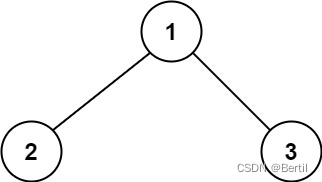
![[OC]-<UI入门>--常用控件的学习](/img/2c/d317166e90e1efb142b11d4ed9acb7.png)
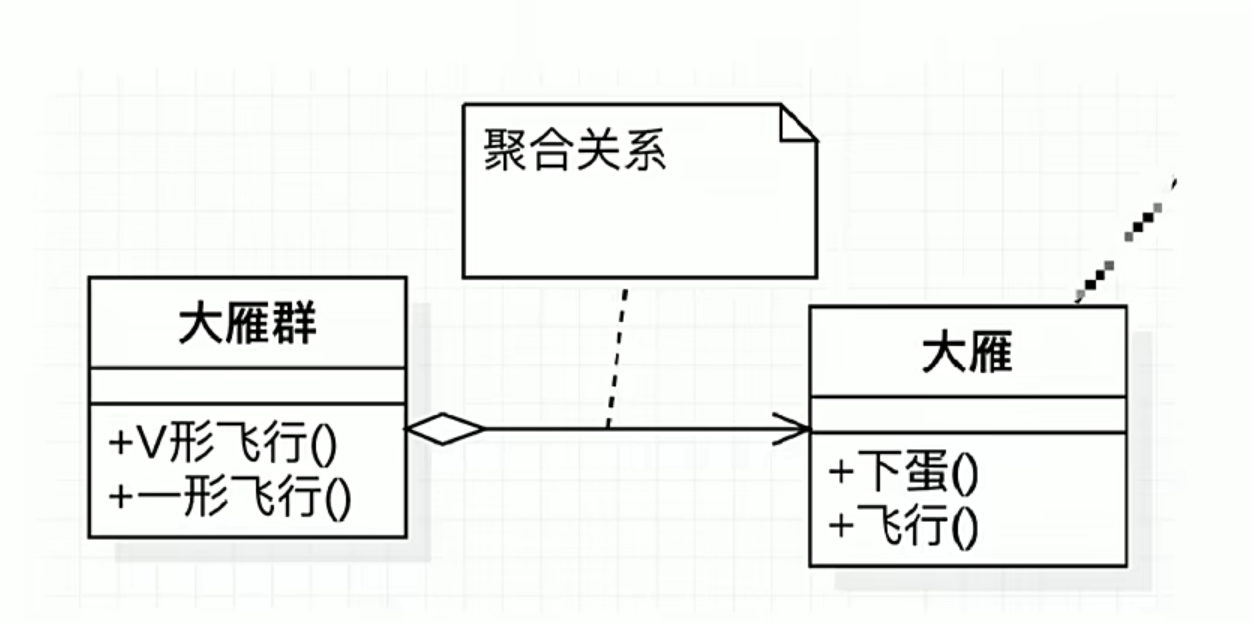
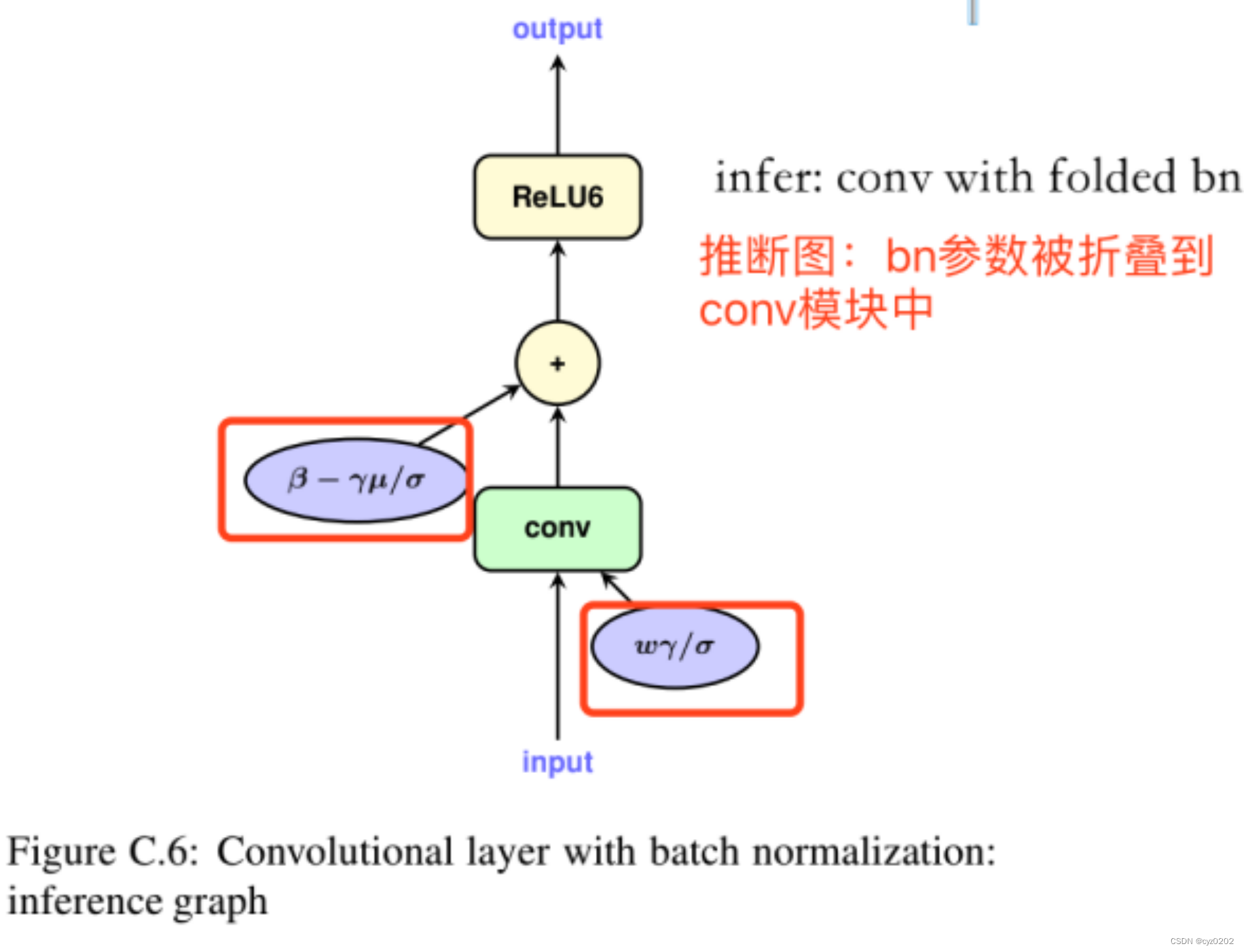
![[OC-Foundation框架]---【集合数组】](/img/b5/5e49ab9d026c60816f90f0c47b2ad8.png)

